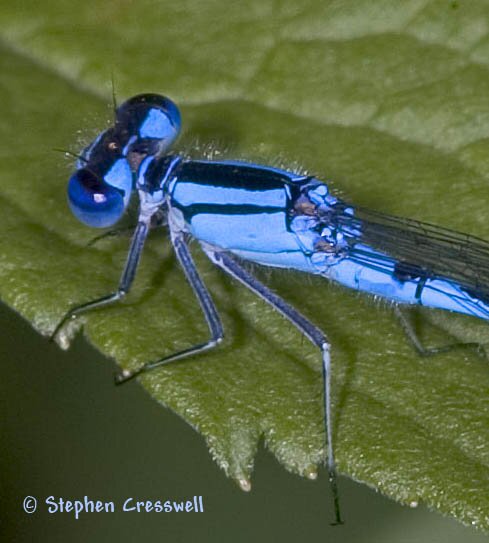

Family: Coenagrionidae
Length: 27-34 mm
To beginning Damselfly watchers, all the bluets may seem to look just alike. The Azure Bluets, though, have clear distinguishing characteristics that enable one to be confident of a correct identification.
One males, look for an abdomen that has the rearmost segment (segment 10) black on the top and blue on the sides, while segments 8 and 9 are blue on the tops and sides. Segment 7 is blue toward the rear and black toward the front, with a characteristic pattern where the two colors meet. Male Azure Bluets have very large blue eyespots.
 Female Azure Bluets look not unlike the males at first glance, but each of the identifying characteristics mentioned for the males is different on the females. On females, the final two segments of the abdomen (9 and 10) are black on the tops and sides. Segment 8 has a pair of small blue spots, and segment 7 has a pair of larger blue spots. The photo at the bottom of this page shows the characteristic size and shape of these two pairs of spots. Another thing to notice about female Azure Bluets is that their eyespots are often greenish, and notably smaller than those of the male.
Female Azure Bluets look not unlike the males at first glance, but each of the identifying characteristics mentioned for the males is different on the females. On females, the final two segments of the abdomen (9 and 10) are black on the tops and sides. Segment 8 has a pair of small blue spots, and segment 7 has a pair of larger blue spots. The photo at the bottom of this page shows the characteristic size and shape of these two pairs of spots. Another thing to notice about female Azure Bluets is that their eyespots are often greenish, and notably smaller than those of the male.
Azure Bluets are found in all parts of the Mountain State, and in fact in most of the Eastern United States and Canada. Look for them at ponds and other small bodies of water. In most cases, if fish are present in a pond, then Azure Bluets are not.
Ingram and Jenner (1976) studied the life history of Enallagma aspersum in the highlands of western North Carolina. They reported that the species spends the winter in the larval stage, in instars F-8 to F-1. Adult emergence was "temporally dispersed." The first emergence was seen on 21 May and the last on 15 September, and there was a brief period in early August where emergence seemed to cease temporarily. The peak of the emergence period was from 29 June to 19 July.
Ingram and Jenner argued that the evidence seemed to point to Enallagma aspersum being a primarily univoltine species, but with about 8% of individuals completely all development in one season, emerging as adults in August and September.

|
|
On the abdomen of males, segment 10 is black on top, while segments 8 and 9 are blue. Segment 7 is partly blue, and has a characteristic pattern where the blue gives way to black. |

Right: Female Azure Bluets are black at the tip of their abdomens. They have two pairs of blue spots, one on segment 8 and one on segment 7. The size and shape of these spots is characteristic of females of this species. Note that on females the eyespots are smaller and are often greenish rather than blue.
Note that this female Azure Bluets has mites attached to her in the area where the thorax meets the abdomen.


